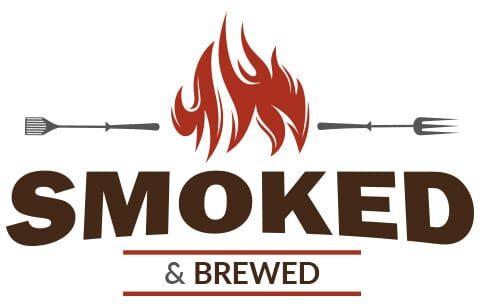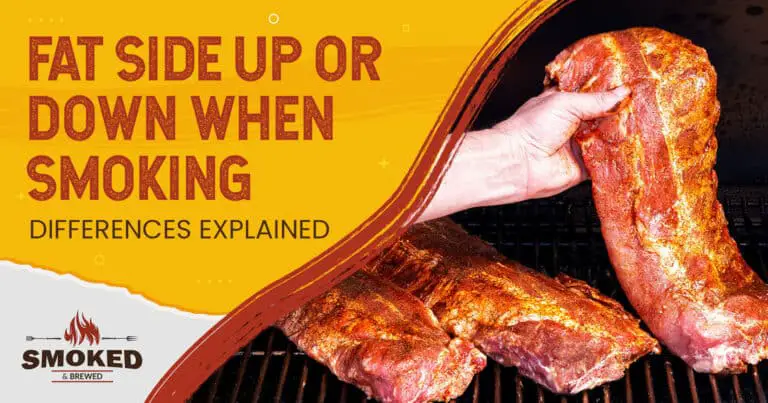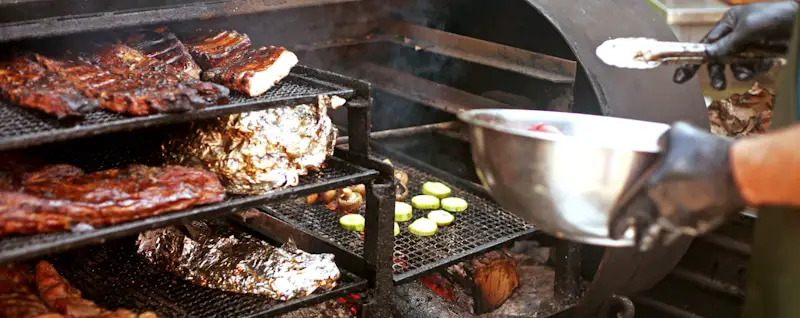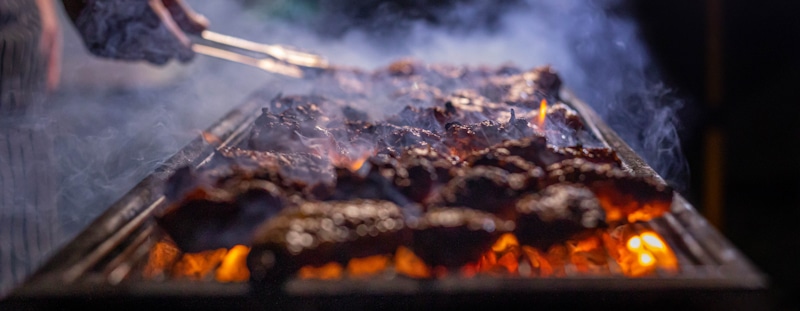Fat up or fat down? There is a lot of controversy in the culinary world when it comes to deciding whether to put the fat side up or down for smoking your favorite and expensive cut of meat.
Briskets, including Corned Beef Brisket should preferably be smoked fat side down. Pork shoulder and Pork Butt may be smoked with fat side up. Smoking with the fat side up keeps the meat juicy and tender, and smoking with the fat side down prevents charring but increases the chances of flare-ups. Flipping the meat halfway through or using the Texas Crutch Method can give the best of both worlds.
Meats like briskets and pork butt have one side with bare meat and the other side with a white layer of ‘fat cap.’ When you clean and process the meat, the fat should never be completely removed as it is the main source of flavor and taste. The fat renders the meat with natural juiciness and prevents it from drying out. Continue reading to find out the key differences between smoking the meat with the fat side up and down.
Fat Side Up Or Down When Smoking A Brisket
Brisket comes from the chest of the cow, and the side facing out is covered with a thick (about 1 inch) and a well-marbled layer of fat. Keeping a layer of ¼ to ⅛ inch thick fat is best for smoking briskets. For the best taste, it is recommended to smoke brisket with the fat side down.
Smoking Brisket Fat Side Down
Most smokers are designed in such a way that the fire or the radiant heat does not directly hit the brisket. However, the conventional heat that flows through the smoker will eventually render the meat dry.
When the fat side is faced down, it not only works as a shield between the underlying fiery source of heat and the delicate meat but also renders it less surface drying of the brisket. Keeping the meat fat side down does not wash away the rub and seasoning and makes the briskets look better.
Another reason to smoke the brisket with the fat side down is when the fat will drip beneath the cooking grate, it will produce more smoke and will instill a rich woodsy and smoky flavor to the brisket.
Expert tip: You can try flipping the brisket halfway through or use butcher paper or aluminum foil (or the ‘Texas Crutch’ method) during the stall phase to help the brisket reabsorb moisture. How to do it? Wrap the brisket tightly into the butcher paper halfway through smoking or until the internal temperature reaches 165 to 170 degrees Fahrenheit (or 73.8℃). Use pink butcher paper (peach-treated) for the best results.
Remember to baste in every turn to restore any lost moisture. As a general rule, briskets cooked in liquid should be fat side up, while those put directly over the heat source should be placed fat side down. If you are using an extra barrier such as aluminum foil, you should definitely place the meat fat side down to provide extra insulation.
Smoking Brisket Fat Side Up
When you cook brisket fat side up, the fat melts and trickles down into the drip pan and washes away most of the seasoning and rubs you have put on the meat. Fat side up actually shoots the temperature faster, however it finishes just about the same time as fat side down.
Remember that smoking brisket with the fat side up does not add moisture to the meat – it is a myth. Cooking the meat with the fat side up also does not render a uniform bark on the meat. However, if you are using a well-insulated offset smoker, you can cook with the fat side up.
Watch this video to compare and understand whether you should cook fat side up or down.
[amalinkspro_table id=”1168″ new-window=”on” nofollow=”on” addtocart=”off” /]
Fat Side Up Or Down When Cooking Corned Beef
Corned beef brisket is brisket cured in brine or salt solution. If you want faster results, you should submerge the corned beef in broth, beer, apple cider vinegar, or any other flavorful liquid before placing it in the smoker. As with regular briskets, corned beef brisket is best smoked with the fat side down.
If you smoke with the fat cap up, the fat over the corned beef will drip down the meat and turn the meat tough and chewy.
Fat Side Up Or Down When Smoking Pork Shoulder or Butt
For larger cuts of meat like pork butt and pork shoulder, where the fat can sometimes be as much as an inch of thickness, it is best to keep the fat side up. The fat will slowly give a natural basting effect, which will keep it tender and juicy. Placing it fat side down will also minimize the chances of flare-ups. However, it is a myth that the fat will penetrate deep into the meat.
Drawback? As the fat melts away and drips down the meat, it may remove some rub from the surface of the meat.
Placing the pork fat side down may initiate flare-ups. The only advantage of keeping the fat side down is that it works as insulation and protects the meat from direct heat. Thus, it will prevent the pork from getting burnt or charred.
You can also choose to flip the pork periodically or halfway through to get the best of both worlds. However, frequent opening and closing of the smoker may increase the overall cooking time and reduce the overall smoky flavor.
Smoking Pork Shoulder Up Or Down
Pork shoulder (also known as Picnic shoulder or picnic roast) is best used for smoking pulled pork, pork roast, or pork slices. It usually has less fat and marbling compared to pork butt and is usually sold with skin on. The pork shoulder has a large fat cap on one of its sides. Placing the pork shoulder fat side up works as ‘self-basting’ and will help the meat to retain a high amount of moisture. If you want medium-rare doneness, prevent charring and enhance the flavor of the bark, you can cook the meat with the fat side down.
Smoking Pork Butt Fat Up Or Down
Pork butt (also known as Boston Butt) is best used for making pulled pork. It is either sold with bone-in or boneless and is very fatty. It is best to cook pork butt with the fat side up. All the fat works as a natural basting liquid that renders flavor and moisture into the meat.
Our Advice
After a thoughtful analysis of all pros and cons, here is a summary of whether to cook fat side up or fat side down when smoking different kinds of meat.
- Brisket – Fat side down
- Pork Butt and Shoulder – Fat side up
- Corned Beef – Fat side down
The fat layer should never be directly put on the grill without placing a dripping pan underneath. If there is nothing to catch the drippings, it can cause a fire.
There is nothing awful than 10 to 12 hours of smoking that transforms into dry and chewy results. Placing the meat fat side up or down will also depend upon the make and model of the smoker. Do remember that if you have a setup that sends heat from above, you would need to place the meat on the opposite side.
Conclusion
Everyone has their taste preferences and a different set of grill/ smoker set-up – and that is exactly why you should give a few hits and trials to understand what works best for you. However, in most cases, the above recommendations work well and give great results every time.
Scot has loved smoking food in his free time for the last few years. Each major holiday or off-weekend, Scot spends days testing and prepping new recipes for perfection.



